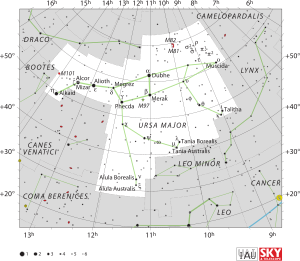The red circle shows the approximate location of Lalande 21185 in Ursa Major | |
| Observation data Epoch J2000.0 Equinox J2000.0 | |
|---|---|
| Constellation | Ursa Major |
| Right ascension | 11h 03m 20.19482s[1] |
| Declination | +35° 58′ 11.5762″[1] |
| Apparent magnitude (V) | 7.520[2] |
| Characteristics | |
| Spectral type | M2V[3] |
| Apparent magnitude (B) | 8.960 ± 0.007[2] |
| Apparent magnitude (V) | 7.520 ± 0.009[2] |
| Apparent magnitude (R) | ~6.6[3] |
| Apparent magnitude (I) | ~5.8[3] |
| Apparent magnitude (J) | 4.203 ±0.242[3] |
| Apparent magnitude (H) | 3.640 ±0.202[3] |
| Apparent magnitude (K) | 3.254 ±0.306[3] |
| U−B color index | +1.074[2] |
| B−V color index | +1.444[2] |
| Variable type | BY[4] |
| Astrometry | |
| Radial velocity (Rv) | −85.11±0.13[1] km/s |
| Proper motion (μ) | RA: −580.057 mas/yr[1] Dec.: −4776.589 mas/yr[1] |
| Parallax (π) | 392.7529 ± 0.0321 mas[1] |
| Distance | 8.3044 ± 0.0007 ly (2.5461 ± 0.0002 pc) |
| Absolute magnitude (MV) | 10.48[5] |
| Details | |
| Mass | 0.389±0.008[6] M☉ |
| Radius | 0.392±0.004[6] R☉ |
| Luminosity (bolometric) | 0.02194±0.00021[6] L☉ |
| Luminosity (visual, LV) | 0.0055[nb 1] L☉ |
| Surface gravity (log g) | 4.895+0.008 −0.010[7] cgs |
| Temperature | 3,547±18[6] K |
| Metallicity [Fe/H] | −0.3621+0.0872 −0.0687[7] dex |
| Rotation | 56.15±0.27 d[8] |
| Age | 8.047+3.958 −4.523[7] Gyr |
| Other designations | |
| Database references | |
| SIMBAD | data |
| Exoplanet Archive | data |
| ARICNS | data |
Lalande 21185 (also known as BD+36 2147, Gliese 411, and HD 95735[3]) is a star in the south of Ursa Major. It is the apparent brightest red dwarf in the northern hemisphere.[nb 2][9][10] Despite this, and being relatively close by, it is very dim (as are all red dwarfs), being only magnitude 7.5 in visible light and thus too faint to be seen with the unaided eye. The star is visible through a small telescope or binoculars.[11]
At 8.304 light-years (2.546 parsecs)[1] away it is one of the stars nearest to the Solar System; only the Alpha Centauri system, Barnard's Star, Wolf 359, and the brown dwarfs Luhman 16 and WISE 0855−0714 are known to be closer.[12] Because of its proximity it is a frequent subject for astronomical surveys and other research and thus is known by numerous other designations, most commonly Gliese 411 and HD 95735. In approximately 19,900 years it will be at its closest, about 4.65 ly (1.43 pc) from the Sun, just over half its present distance.[13][14]
Lalande 21185 has two known exoplanets and one candidate exoplanet, making it the third closest confirmed planetary system to the Solar System.
- ^ a b c d e f Cite error: The named reference
Gaia3was invoked but never defined (see the help page). - ^ a b c d e Cite error: The named reference
aaass61was invoked but never defined (see the help page). - ^ a b c d e f g h "HD 95735". SIMBAD. Centre de données astronomiques de Strasbourg. Retrieved 2009-05-29.
- ^ Cite error: The named reference
gcvswas invoked but never defined (see the help page). - ^ Cite error: The named reference
johnsonwas invoked but never defined (see the help page). - ^ a b c d Cite error: The named reference
Pineda2021was invoked but never defined (see the help page). - ^ a b c Cite error: The named reference
Hurt2021was invoked but never defined (see the help page). - ^ Cite error: The named reference
Stock2020was invoked but never defined (see the help page). - ^ Dickinson, David (2015-12-23). "14 Red Dwarf Stars to View with Backyard Telescopes". Universe Today. Retrieved 2016-12-04.
- ^ Croswell, Ken (July 2002). "The Brightest Red Dwarf". KenCroswell.com. Retrieved 2016-12-04.
- ^ Cite error: The named reference
sherrod_koed2003was invoked but never defined (see the help page). - ^ Cite error: The named reference
Reylé2021was invoked but never defined (see the help page). - ^ Cite error: The named reference
García-Sánchez2001was invoked but never defined (see the help page). - ^ "Annotations on HD 95735 object". Centre de données astronomiques de Strasbourg. Retrieved 2010-04-14.
Cite error: There are <ref group=nb> tags on this page, but the references will not show without a {{reflist|group=nb}} template (see the help page).
